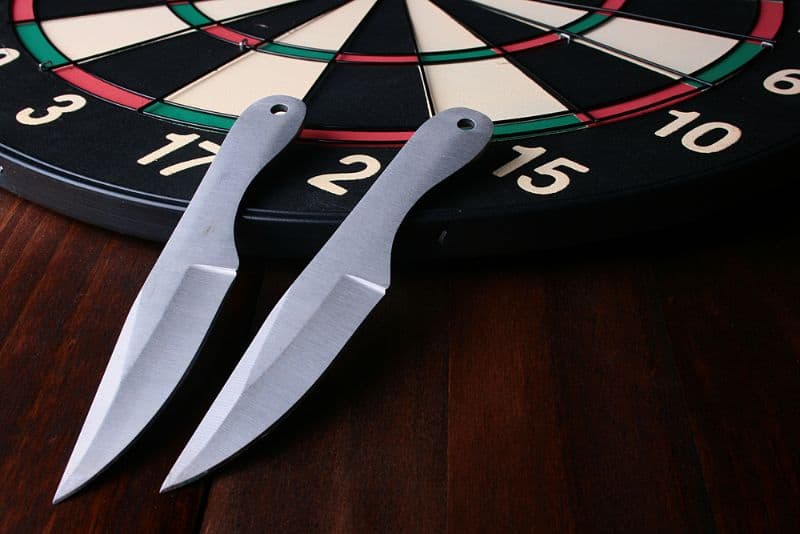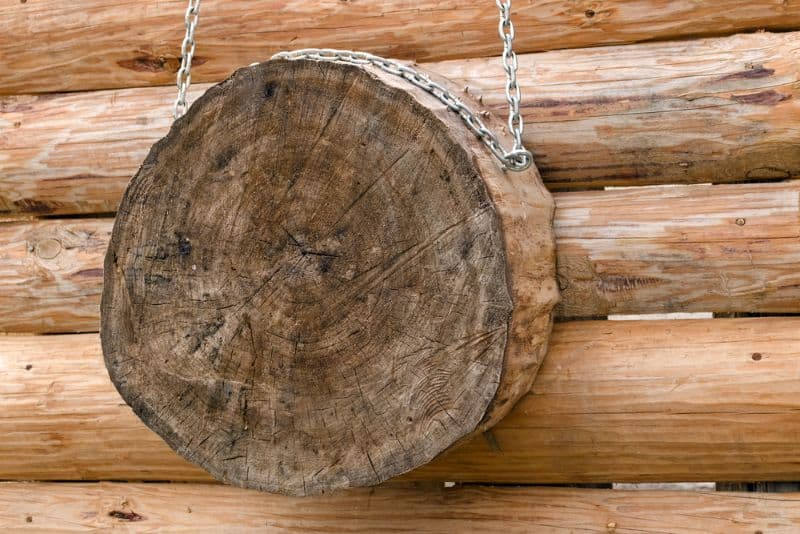For Knife throwing enthusiasts, it can be tempting to set up a rudimentary throwing range and let the blades fly. However, depending on where you live, finding a place where you can safely enjoy your sport of choice can be costly and time-consuming.
Knife throwing can absolutely be done at home. Still, there are some special factors to consider to ensure your safety. Size of the indoor space, materials of the target, and insulation are the most important factors.

You’re probably thinking, why should I drive out to the middle of nowhere or pay to use a range when I have a backyard?
While indoor knife throwing and Knife throwing at home can be done, there are some special things to consider.
First, the size of your indoor space is the most significant factor in deciding whether you can safely throw knives indoors. Knife throwing in a space that is too small runs the risk of serious injury and destruction to property.
Second, the knives themselves and the targets will differ. You’ll also have to insulate your indoor area and defend against blades potentially bouncing back.
The same goes for throwing knives at home in a backyard. After all, Knife throwing in a large, wooded area in the countryside is quite different from doing so in a small yard in a cramped suburb.
Read on to learn more about safely throwing knives indoors and at home.
Can Knife Throwing be Done Indoors?
The short answer to this is yes – but it largely depends on the space available.
There should be at least 7 feet of space between the thrower and the target, but this is a bare minimum. Most throwing ranges have up to 20 feet between the thrower and the target to avoid dangerous rebounds.
Indoor knife throwing can be considerably more dangerous than throwing outside due to the knives rebounding. The rebound risk applies to the target and the walls and floor – any surface your knife can potentially hit and ricochet from.
There’s also the surrounding area to consider. For example, you would want to avoid throwing knives at a target poised beside grandma’s priceless antique dining room set!
Knives can, in some cases, go through walls made of non-wood materials such as sheetrock when thrown hard enough. We don’t need to explain why this is dangerous. They can shatter windows, go through glass, destroy furniture, and wreak all havoc on indoor spaces.
The moral of the story: make sure your indoor space is fully equipped to handle knife throwing.
How to Prepare an Area for Indoor Knife Throwing
First, you’ll want to make sure you have available space. A spare bedroom in your house is unlikely to suffice due to size restrictions.
The best indoor space is a workshop, a garage, or even a large basement, where the walls and floor can be insulated against knife impacts.
As stated above, the distance between the target and the thrower should be between 7 – 20 feet (ideally at the longer end of that range).
The floor should be concrete covered with a thin layer of carpet (for shock absorption), and the wall behind the target should be covered with concrete in order to minimize ricochet.
The same goes for the walls; cardboard absorbs throws and ensures the knives won’t bounce off it.
Making Individual Lanes
Commercial indoor throwing knife ranges have individual lanes separated by durable material. This can be recreated in your own indoor space.
Individual lanes should be separated by a durable material that the knives cannot penetrate nor ricochet from. There are a few options for this:
• Plexiglass – while the blades will scratch this material after prolonged use, they won’t penetrate.
• Foam or soft rubber – though this will be damaged in the long run and will need to be replaced frequently
• Cinderblock walls covered with thin carpet or cardboard – though this option is relatively impractical and can be time-consuming.
Can I Use Wood Targets in Indoor Knife Throwing?
Yes, but this depends on the size of your indoor space. Wood – especially hardwood such as oak or walnut – is hazardous due to knives bouncing off.
Knives often bounce off of wood and can be extremely dangerous when rebounding. This is fine outside, where there is a great deal of space between the target and thrower, but not in smaller indoor spaces.
Softwood is okay to use indoors but should be covered with cardboard and/or backed by a layer of rubber to reduce vibration and ricochet.

What Materials Should I Use for Indoor Knife Throwing Targets?
While hardwood like oak or plywood can be a great base, you should add several layers of cardboard on the target’s surface. This ensures that the Knife will stick firmly into the cardboard instead of bouncing off, as with a wood target.
Softwood can be used as indoor targets, provided you have a large space. The best softer woods for indoor Knife throwing targets are:
• Cottonwood
• Poplar
• Spruce
• Pine
• Palm
Knives tend to stick in softwood rather than bouncing off. Some – particularly cottonwood – tend to absorb moisture and close up the holes the blades make in the wood’s surface.
Adding a rubber slab behind the target can help minimize vibration and reduce ricochet – ideal in an indoor space.
Find the right indoor knife throwing target with our pros and cons comparison chart
| Type of Target | Pros | Cons |
|---|---|---|
| Cardboard Targets | Affordable, easy to make, disposable | Not very durable, may not hold knives securely |
| Soft Wood Targets | Absorbs moisture, knives tend to stick | May need to be backed by rubber to reduce vibration and ricochet |
| Cottonwood Target | Absorbs moisture, knives tend to stick | Ideal for indoor knife throwing |
| Poplar Target | Knives tend to stick, affordable | Ideal for indoor knife throwing |
| Spruce Target | Knives tend to stick, affordable | Ideal for indoor knife throwing |
| Pine Target | Knives tend to stick, affordable | Ideal for indoor knife throwing |
| Palm Target | Knives tend to stick, affordable | Ideal for indoor knife throwing |
Can I Use the Same Blades when Throwing Indoors as I do Outdoors?
For indoor knife throwing, it’s recommended that you use smaller blades with sharper tips.
Smaller blades are lighter and therefore don’t bounce as much, and those with sharp tips are more likely to stick firmly in the target.
key Safety Measures to be Followed while Practicing Indoor knife throwing
| Safety Measure | Tips to Prevent Accidents |
|---|---|
| Wear protective gear | Wear closed-toe shoes, long sleeves, and eye protection |
| Clear the area | Ensure that there are no people, pets, or breakable objects in the vicinity of the target |
| Follow proper throwing techniques | Do not over-throw or under-throw, and keep your arm straight |
| Check the knives regularly | Ensure that the knives are sharp, balanced, and free from any damage |
| Never throw towards another person | Always keep a safe distance from others and never throw towards another person, even if they are wearing protective gear |
| Store knives safely | Keep the knives in a secure, safe place when not in use to prevent accidental injuries. |
Final Thoughts
Having an indoor throwing knife range at home can be extremely rewarding and allow you to hone your Knife throwing skills on your own time. Don’t have to schedule and pay for time at a local range to practice? Count us in!
But to do it safely, you need to have adequate space, target materials that absorb shock and reduce ricochet, and proper insulation to protect yourself and the surrounding property.

